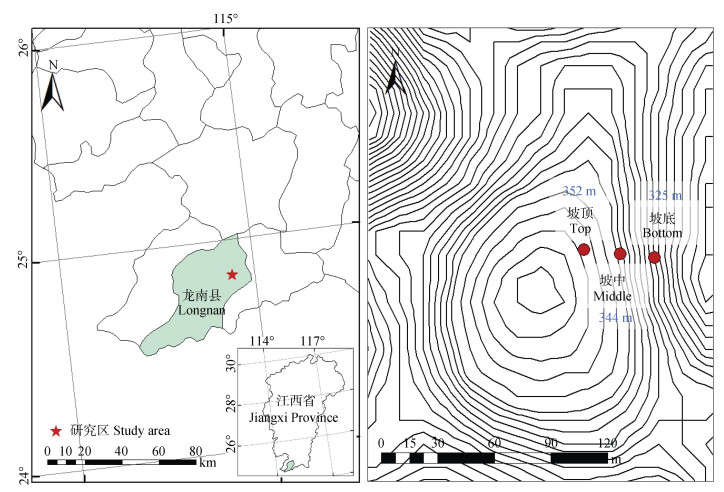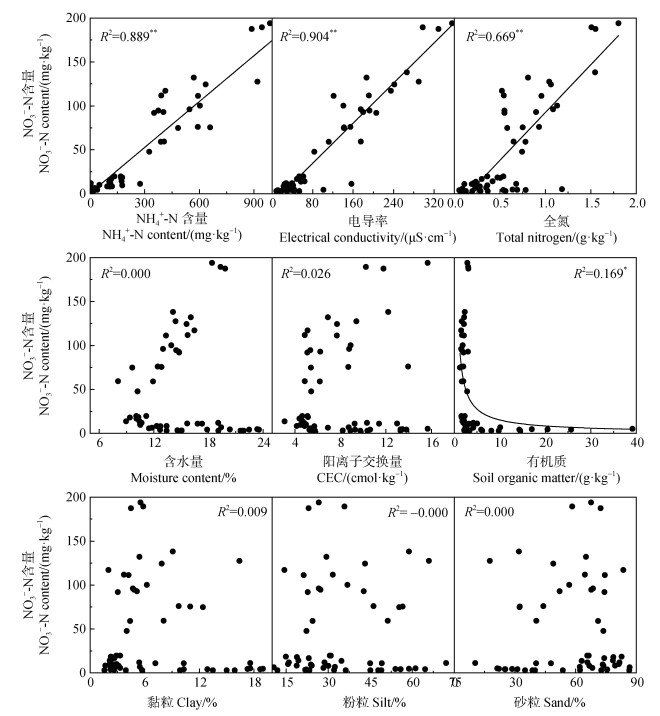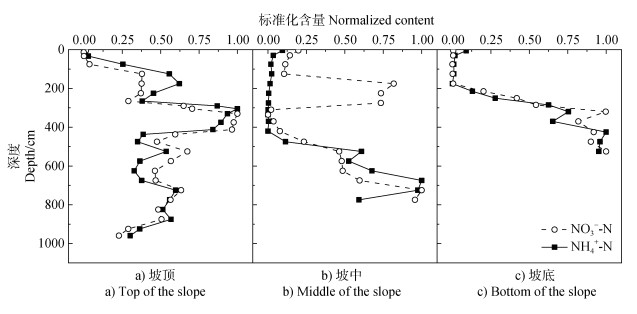2. 中国科学院大学, 北京 100049;
3. 中国科学院南京地理与湖泊研究所, 南京 210008
2. University of Chinese Academy of Sciences, Beijing 100049, China;
3. Nanjing Institute of Geography and Limnology, Chinese Academy of Sciences, Nanjing 210008, China
赣南地区现存900多座废弃的离子型稀土矿[1],近年来采用原地浸矿工艺开采的稀土矿约占总面积30%[2]。原地浸矿尾矿山易发生水土流失、土壤酸化,尾矿山周围水体氨氮严重超标,硝酸盐污染严重[3-4]。已有研究发现赣江流域干流硝态氮(
地表水
尾矿区水体中具有的高含量
本研究选择赣南一座采用原地浸矿工艺开采后的离子型稀土矿山作为研究区,其所处区域属于亚热带湿润季风气候,年均温为19.5℃,年均降水量为1 479.1 mm[19],降雨主要集中在4至6月[20]。矿山位于赣江上游,赣江流域多年平均年径流总量为283.3×108 m3 [21]。从地质构造来看,研究区地处环太平洋边缘,位于后加里东隆起区南部,在多期地质活动后呈棋盘格式构造形迹[22]。在地质历史时期中,活跃的构造岩浆活动创造了良好的离子型稀土矿形成条件[23]。
采样矿山位于江西省赣州市龙南县城东南方向约10 km(图 1),富含中重稀土[24]。龙南县一半以上矿山采用硫酸铵作为浸矿剂进行原地浸矿开采[2],较为典型。该矿山属于三南矿集区[22],主要岩体为黑云母钾长花岗岩[25],自然植被下的地带性土壤类型为湿润富铁土。矿山高程为352 m,坡度达37°,整体植被覆盖度高,以马尾松、杉木等为优势物种。矿山在山顶修筑有浸矿液池存放硫酸铵溶液,山坡上按0.5~2 m网格修建注液井(直达含矿层1 m左右),山底开挖集液沟。开采过程中硫酸铵溶液通过注液井直接注入矿体内部,沿土壤孔隙进行扩散,与黏土矿物表面吸附的稀土离子充分交换,形成的稀土母液沿基岩面进入集液沟[26]。该矿山自2015年开采完成后,无人为扰动,但保留部分原有采矿设施。采样矿山的地质、地貌和植被类型均与该区域的矿山一致,具有一定的代表性。

|
图 1 研究区位置和采样点位置 Fig. 1 Study area and sampling sites |
本研究于2019年11月进行野外采样。在已开采矿山的坡顶、坡中及坡底分别选择一个点位(图 1),使用洛阳铲由表土采至基岩面。1 m深以上的土壤按发生层取样,1 m深以下间隔50 cm采集一份土壤样品,当50 cm范围内土壤颜色、结构、紧实度等存在明显差异时,需要分段取样。坡顶、坡中及坡底处的土体深度分别为9.7 m、8.0 m及5.5 m。坡顶、坡中及坡底表层(腐殖质层)厚度为10 cm、8 cm及10 cm[12],腐殖层以下至半风化体间的土壤层分别为10~300 cm、8~400 cm、10~250 cm,半风化层为300~970 cm、400~800 cm及250~550cm,稀土开采过程中直接向该土层注入浸矿剂。取样过程中,现场直接将小部分土壤样品低温保存,用以测定土壤
土壤
尾矿山整体土壤

|
图 2 研究区土壤硝态氮含量统计图 Fig. 2 Statistical diagram of soil nitrate nitrogen content in the study area |
从土体内部垂直方向来看,稀土尾矿山不同土层间土壤

|
图 3 土壤硝态氮含量剖面分布图 Fig. 3 Distribution of nitrate nitrogen content in the soil profiles |
整体来看,浸矿区坡顶到坡底的表层土壤
坡顶处土壤
研究区土壤

|
注:* P<0. 05,** P<0. 01(双尾检验);所有参数样本量n =56。 Note: * P < 0. 05, ** P < 0. 01(Two-tailed test)Number of samples: 56
图 4 硝态氮与其他土壤理化特征之间的相关性 Fig. 4 Correlation between |
矿山坡顶、坡中及坡底
尾矿山土壤
土壤含水量影响硝化及反硝化过程[32]。但本研究发现土壤
渗流是土壤

|
图 5 土壤硝态氮与铵态氮含量随土体的变化趋势 Fig. 5 The variation trend of soil nitrate nitrogen and ammonium nitrogen in the soil profile |
土壤中残留的
土壤中
该矿山于2015年开采完成,矿山开采结束4年后尾矿山土壤仍富集大量
离子型稀土原地浸矿尾矿山土壤
| [1] |
Liu Y, Xiong L, Wu Y F. Investigation and analysis on the geo-environment problem of abandoned mines in Jiangxi Province (In Chinese)[J]. Jiangxi Science, 2021, 39(3): 483-489. [刘云, 熊立, 吴雨夫. 江西省废弃矿山地质环境问题调查与分析[J]. 江西科学, 2021, 39(3): 483-489.]
(  0) 0) |
| [2] |
Xiong T W, Jiang F, Qi S H. Remote sensing dynamic monitoring on rare earth mining area and its vegetation restoration of 6 counties in southern Jiangxi (In Chinese)[J]. Soil and Water Conservation in China, 2018(1): 40—44, 69. DOI:10.3969/j.issn.1000-0941.2018.01.016 [熊恬苇, 江丰, 齐述华. 赣南6县稀土矿区分布及其植被恢复的遥感动态监测[J]. 中国水土保持, 2018(1): 40—44, 69.]
(  0) 0) |
| [3] |
Guo Z Q, Zhao K, Jin J F, et al. Reviews on environmental assessment and pollution prevention of ion adsorption type rare earth ores (In Chinese)[J]. Chinese Rare Earths, 2019, 40(3): 115-126. [郭钟群, 赵奎, 金解放, 等. 离子型稀土矿环境风险评估及污染治理研究进展[J]. 稀土, 2019, 40(3): 115-126.]
(  0) 0) |
| [4] |
Guo Z Q, Zhao K, Jin J F, et al. Problems facing ion adsorption type rare earth exploitation and research progresses on green extraction (In Chinese)[J]. Chemical Industry and Engineering Progress, 2019, 38(7): 3425-3433. [郭钟群, 赵奎, 金解放, 等. 离子型稀土开发面临的问题与绿色提取研究进展[J]. 化工进展, 2019, 38(7): 3425-3433.]
(  0) 0) |
| [5] |
Wang P, Qi S H, Chen B. Characteristics of nitrate and nitrogen stable isotope in Ganjiang River under the influence of land use (In Chinese)[J]. Journal of Lake Sciences, 2015, 27(6): 1011-1019. [王鹏, 齐述华, 陈波. 土地利用方式影响下的赣江硝态氮浓度和氮稳定同位素分布特征[J]. 湖泊科学, 2015, 27(6): 1011-1019.]
(  0) 0) |
| [6] |
Li Y, Liang Y, Cao L X, et al. Transport of ammonia nitrogen pollutants in ionic rare earth mining small watershed (In Chinese)[J]. Soils, 2021, 53(6): 1271-1280. [李宇, 梁音, 曹龙熹, 等. 离子型稀土矿区小流域氨氮污染物地表迁移特征[J]. 土壤, 2021, 53(6): 1271-1280.]
(  0) 0) |
| [7] |
Zhang Q Z, Chen X, Shen S M. Advances in studies on accumulation and leaching of nitrate in farming soil (In Chinese)[J]. Chinese Journal of Applied Ecology, 2002, 13(2): 233-238. DOI:10.3321/j.issn:1001-9332.2002.02.026 [张庆忠, 陈欣, 沈善敏. 农田土壤硝酸盐积累与淋失研究进展[J]. 应用生态学报, 2002, 13(2): 233-238.]
(  0) 0) |
| [8] |
Dong Y, Yang J L, Zhao X R, et al. Nitrate leaching and N accumulation in a typical subtropical red soil with N fertilization[J]. Geoderma, 2022, 407: 115559. DOI:10.1016/j.geoderma.2021.115559
(  0) 0) |
| [9] |
Williard K W J, Dewalle D R, Edwarda P J, et al. 18O isotopic separation of stream nitrate sources in mid-Appalachian forested watersheds[J]. Journal of Hydrology, 2001, 252(1/4): 174-188.
(  0) 0) |
| [10] |
Zhang Q Y, Shu W, Li F, et al. Nitrate source apportionment and risk assessment: A study in the largest ion-adsorption rare earth mine in China[J]. Environmental Pollution, 2022, 302: 119052. DOI:10.1016/j.envpol.2022.119052
(  0) 0) |
| [11] |
Marion C, Li R, Waters K E. A review of reagents applied to rare-earth mineral flotation[J]. Advances in Colloid and Interface Science, 2020, 279: 102142. DOI:10.1016/j.cis.2020.102142
(  0) 0) |
| [12] |
Xu Z, Yang J L, Zhang G L, et al. Enrichment characteristics of soil ammonium nitrogen in ionic rare earth mining area (In Chinese)[J]. Acta Pedologica Sinica, 2023, 60(1): 106-116. [许哲, 杨金玲, 张甘霖, 等. 离子型稀土闭矿区土壤铵态氮富集特征[J]. 土壤学报, 2023, 60(1): 106-116.]
(  0) 0) |
| [13] |
He J Z, Zhang L M. Key processes and microbial mechanisms of soil nitrogen transformation (In Chinese)[J]. Microbiology China, 2013, 40(1): 98-108. [贺纪正, 张丽梅. 土壤氮素转化的关键微生物过程及机制[J]. 微生物学通报, 2013, 40(1): 98-108.]
(  0) 0) |
| [14] |
Zhang J B, Song C C. Research progress of soil nitrogen transformation (In Chinese)[J]. Jilin Agricultural Sciences, 2004, 29(1): 38—43, 46. DOI:10.3969/j.issn.1003-8701.2004.01.011 [张金波, 宋长春. 土壤氮素转化研究进展[J]. 吉林农业科学, 2004, 29(1): 38—43, 46.]
(  0) 0) |
| [15] |
Peng C, Pan X D, Jiao Y J, et al. Identification of nitrate pollution sources through various isotopic methods: A case study of the Huixian wetland (In Chinese)[J]. Environmental Science, 2018, 39(12): 5410-5417. [彭聪, 潘晓东, 焦友军, 等. 多种同位素手段的硝酸盐污染源解析: 以会仙湿地为例[J]. 环境科学, 2018, 39(12): 5410-5417.]
(  0) 0) |
| [16] |
Smith V H, Schindler D W. Eutrophication science: Where do we go from here?[J]. Trends in Ecology & Evolution, 2009, 24(4): 201-207.
(  0) 0) |
| [17] |
Johnson P T J, Townsend A R, Cleveland C C, et al. Linking environmental nutrient enrichment and disease emergence in humans and wildlife[J]. Ecological Applications, 2010, 20(1): 16-29. DOI:10.1890/08-0633.1
(  0) 0) |
| [18] |
Grizzetti B, Bouraoui F, Billen G, et al. Nitrogen as a threat to European water quality . London: Cambridge University Press, 2011: 379-404.
(  0) 0) |
| [19] |
Chen F, Xiong R Z, Zhong L X, et al. Zudong Longnan County area landslide hazard assessment by the information model and ArcGIS (In Chinese)[J]. Nonferrous Metals Science and Engineering, 2017, 8(4): 80-85. [陈飞, 熊如宗, 钟连祥, 等. 基于信息量模型与ArcGIS的龙南县足洞地区滑坡危险性评价[J]. 有色金属科学与工程, 2017, 8(4): 80-85.]
(  0) 0) |
| [20] |
Wu S Q, Tang C J, Zheng T H, et al. Sptio-temporal characteristics of drought in Jiangxi based on index of continuous days without available precipitation (In Chinese)[J]. Resources and Environment in the Yangtze Basin, 2022, 31(4): 903-914. [吴少强, 汤崇军, 郑太辉, 等. 基于连续无有效降雨日数指标的江西省干旱时空分布特征[J]. 长江流域资源与环境, 2022, 31(4): 903-914.]
(  0) 0) |
| [21] |
Liu X G, Li C Y, Wu D Y. Changing characteristic and its impact factor analysis of stream flow and sediment of Ganjiang River Basin during past 60 years (In Chinese)[J]. Resources and Environment in the Yangtze Basin, 2015, 24(11): 1920-1928. DOI:10.11870/cjlyzyyhj201511016 [刘星根, 李昌彦, 吴敦银. 近60年赣江水沙变化特征及影响因素分析[J]. 长江流域资源与环境, 2015, 24(11): 1920-1928.]
(  0) 0) |
| [22] |
Zhang L, Wu K X, Chen L K, et al. Overview of metallogenic features of ion-adsorption type REE deposits in southern Jiangxi Province (In Chinese)[J]. Journal of the Chinese Society of Rare Earths, 2015, 33(1): 10-17. DOI:10.11785/S1000-4343.20150102 [张恋, 吴开兴, 陈陵康, 等. 赣南离子吸附型稀土矿床成矿特征概述[J]. 中国稀土学报, 2015, 33(1): 10-17.]
(  0) 0) |
| [23] |
Wu C Y. The study of ion-adsorbed type of rare earth deposits in weathering crust from south Jiangxi and north Guangdong provinces[D]. Beijing: Chinese Academy of Geological Sciences, 1988.[吴澄宇. 赣南粤北地区风化壳离子吸附型稀土矿床研究[D]. 北京: 中国地质科学院, 1988.]
(  0) 0) |
| [24] |
Jin S L, Huang Y Z, Hu Y, et al. Rare earth elements content and health risk assessment of soil and crops in typical rare earth mine area in Jiangxi Province (In Chinese)[J]. Acta Scientiae Circumstantiae, 2014, 34(12): 3084-3093. [金姝兰, 黄益宗, 胡莹, 等. 江西典型稀土矿区土壤和农作物中稀土元素含量及其健康风险评价[J]. 环境科学学报, 2014, 34(12): 3084-3093.]
(  0) 0) |
| [25] |
Wu C Y, Huang D H, Guo Z X. Ree geoche istry in the weathering process of granites in Longnan County, Jiangxi Province (In Chinese)[J]. Acta Geological Sinica, 1989, 63(4): 349—362, 387. [吴澄宇, 黄典豪, 郭中勋. 江西龙南地区花岗岩风化壳中稀土元素的地球化学研究[J]. 地质学报, 1989, 63(4): 349—362, 387.]
(  0) 0) |
| [26] |
Luo X P, Zhang Y B, Zhou H P, et al. Review on the development and utilization of ionic rare earth ore[J]. Minerals, 2022, 12(5): 554. DOI:10.3390/min12050554
(  0) 0) |
| [27] |
Jones D L, Willett V. Experimental evaluation of methods to quantify dissolved organic nitrogen(DON) and dissolved organic carbon(DOC) in soil[J]. Soil Biology and Biochemistry, 2006, 38(5): 991-999. DOI:10.1016/j.soilbio.2005.08.012
(  0) 0) |
| [28] |
Zhang G L, Gong Z T. Soil survey laboratory methods (In Chinese). Beijing: Science Press, 2012. [张甘霖, 龚子同. 土壤调查实验室分析方法[M]. 北京: 科学出版社, 2012.]
(  0) 0) |
| [29] |
Burt R. Soil survey laboratory methods manual . Lincoln: USDA Natural Resources Conservation Service, 2004.
(  0) 0) |
| [30] |
Zou G H, Zhao F L, Shan Y. Vertical distribution of nitrogen and its influencing factors under different land use patterns in a typical red soil region (In Chinese)[J]. Journal of Ecology and Rural Environment, 2019, 35(5): 644-650. [邹刚华, 赵凤亮, 单颖. 典型红壤区不同土地利用方式下氮素垂直分布及其影响因素[J]. 生态与农村环境学报, 2019, 35(5): 644-650.]
(  0) 0) |
| [31] |
Liu Z X, Chen X M, Jing Y, et al. A study on spatial variance of soil nutrients on the farmland scale in dryland of red soil based on geostatistics (In Chinese)[J]. Chinese Journal of Soil Science, 2013, 44(2): 392-397. [刘祖香, 陈效民, 靖彦, 等. 基于地统计学的农田尺度旱地红壤养分空间变异性研究[J]. 土壤通报, 2013, 44(2): 392-397.]
(  0) 0) |
| [32] |
Zhang J, Cai Z, Müller C. Terrestrial N cycling associated with climate and plant-specific N preferences: A review[J]. European Journal of Soil Science, 2018, 69(3): 488-501. DOI:10.1111/ejss.12533
(  0) 0) |
| [33] |
Zhang Y, Wang Z L, Li Y M, et al. Study on the soil factors influencing nitrogen loss through surface runoff and leakage in Dianchi watershed (In Chinese)[J]. Chinese Journal of Soil Science, 2012, 43(4): 916-922. [张燕, 王自林, 李永梅, 等. 滇池流域农田土壤氮素流失影响因子研究[J]. 土壤通报, 2012, 43(4): 916-922.]
(  0) 0) |
| [34] |
Liu S H, Liu H Y, Luo P, et al. Spatial and temporal distribution characteristics of rainfall of different magnitudes in Pingjiang Basin of upper Ganjiang River in recent 30 years (In Chinese)[J]. Research of Soil and Water Conservation, 2022, 29(3): 106-114. [刘声洪, 刘惠英, 罗萍, 等. 赣江上游平江流域近30年不同量级降雨时空分布特征[J]. 水土保持研究, 2022, 29(3): 106-114.]
(  0) 0) |
| [35] |
Fan J, Hao M, Malhi S S. Accumulation of nitrate N in the soil profile and its implications for the environment under dryland agriculture in Northern China: A review[J]. Canadian Journal of Soil Science, 2010, 90(3): 429-440. DOI:10.4141/CJSS09105
(  0) 0) |
| [36] |
Bundy L G, Malone E S. Effect of residual profile nitrate on corn response to applied nitrogen[J]. Soil Science Society of America Journal, 1988, 52(5): 1377-1383. DOI:10.2136/sssaj1988.03615995005200050032x
(  0) 0) |
| [37] |
Cameron K C, Di H J, Moir J L. Nitrogen losses from the soil/plant system: A review[J]. Annals of Applied Biology, 2013, 162(2): 145-173. DOI:10.1111/aab.12014
(  0) 0) |
| [38] |
Chen Y Q, He B X, Huang J X, et al. Effects on the growth and root morphogenesis of Pinus massoniana seedlings under different slow-released fertilizer application (In Chinese)[J]. Forestry and Environmental Science, 2021, 37(4): 16-23. DOI:10.3969/j.issn.1006-4427.2021.04.003 [陈一群, 何波祥, 黄建雄, 等. 缓释肥对马尾松苗木生长和根系形态建成的影响[J]. 林业与环境科学, 2021, 37(4): 16-23.]
(  0) 0) |
| [39] |
Yan X L, Hu W J, Ma Y F, et al. Nitrogen uptake preference of Cunninghamia lanceolata, Pinus massoniana, and Schima superba under heterogeneous nitrogen supply environment and their root foraging strategies (In Chinese)[J]. Scientia Silvae Sinicae, 2020, 56(2): 1-11. [闫小莉, 胡文佳, 马远帆, 等. 异质性供氮环境下杉木、马尾松、木荷氮素吸收偏好及其根系觅氮策略[J]. 林业科学, 2020, 56(2): 1-11.]
(  0) 0) |
 2024, Vol. 61
2024, Vol. 61


